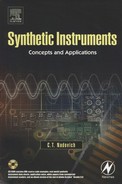Acknowledgments
Although they are clearly the main focus, this book is not just about the synthetic instruments themselves. It also includes an ample helping of what I hope is my wisdom (others may call it my “jaded opinion”) based on my experience regarding how synthetic instruments and synthetic measurement systems should be built and used. I openly admit that my experience is colored by the particular companies and products that I’ve worked for over the years. I have fought many a technical battle to get things done in what I perceived was the right way. I’ve won some, lost some, and in some cases I changed my perception as I was convinced I was wrong.
Regardless of my personal opinion relative to the actual practices in real-world systems, it should not be construed that any particular failure or mistake I may analyze is associated with any specific real-world system or product just because of where I may have worked. Without significant exception, all the valuable opinions I express in this book (and whatever pearls of wisdom they may contain) are derived from the successes I have been involved with, one way or the other.
My interest in synthetic instruments would have never begun if it wasn’t for the influence of Jack Berlekamp, who led me into this topic back in the 1990’s. Jack was a prominent champion of the idea, and I watched him struggle again and again to teach others the techniques and associated benefits of synthetic instrumentation. His crusade convinced me of the importance of setting down, in book form, what synthetic instruments were all about.
Bill Birurakis, who, to my knowledge, invented the term synthetic instrument was another of my teachers. Although I interacted with Bill far less than with Jack, Bill’s influence on my vision of synthetic instrumentation was substantial. Bill’s crystal clear vision of what synthetic instruments are (and are not) eventually penetrated my dull brain. I don’t always agree with Bill on some of the gory details, or Jack for that matter, but much of my own point of view on the topic is a “synthesis” of these two individuals, with “parameterization” and “canonicalization” of my own, for bad or for good.
Any good writing found in the book is a result of Chris Lett’s patient, yet ruthless proofreading suggestions. Chris has proofread every major bit of writing I’ve ever done. What little writing skill I may seem to have, I owe entirely to his literary influence over the years. Dan Frey and Jeff Bronfeld also contributed valuable suggestions to the book as they suffered through proofreading early drafts.
There are many other people, too numerous to list, with whom I’ve worked at Aeroflex, Flam & Russell, Checkpoint Systems, and other companies that had significant influence on my view of automated test. Their impact on this book is considerable.
